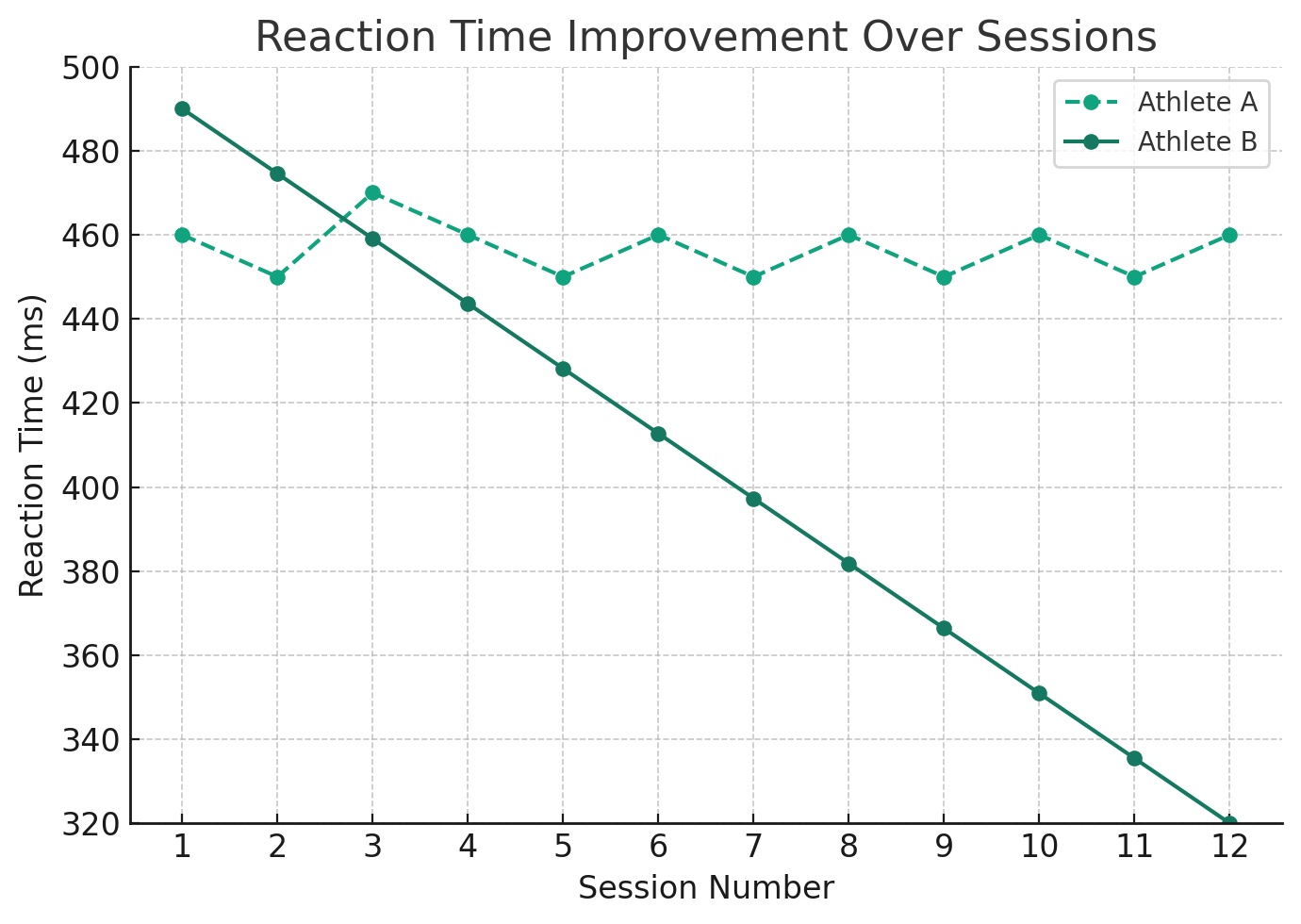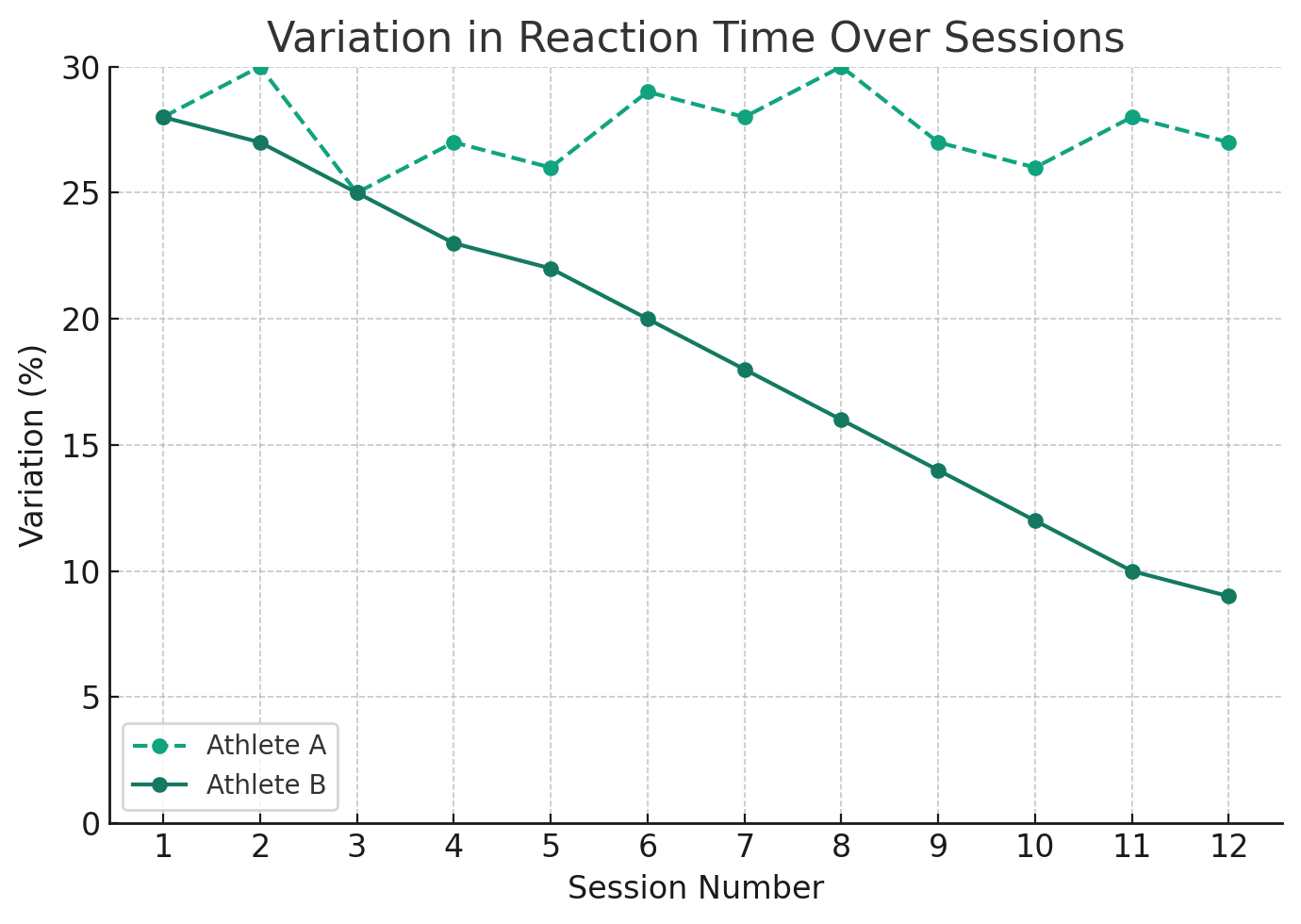Deciphering True Progress: Is Your Athlete Really Improving Their Reaction Time?
Reaction time, a key aspect of cognitive skills and decision-making, isn't just about swift responses; it's about consistent, reliable performance. This blog delves into the nuances of measuring and interpreting reaction time, offering insights into how to effectively identify genuine progress.

In the fast-paced arena of sports, understanding and improving reaction time is pivotal for athlete performance. However, the real challenge for coaches and athletes alike is discerning whether there is actual improvement in this critical area. Reaction time, a key aspect of cognitive skills and decision-making, isn't just about swift responses; it's about consistent, reliable performance. This blog delves into the nuances of measuring and interpreting reaction time, offering insights into how to effectively identify genuine progress.
Understanding Reaction Time
Why Quick Reflexes Aren't Everything in Sports
When we talk about what makes an athlete stand out, reaction time often tops the list. It's all about how swiftly and smartly they can respond during a game. But here's the thing – it's not just about being quick. Consistency is key.
Think about it: in sports where every second counts, being able to reliably respond time and again is what sets the best athletes apart. It's like having a superpower where you're not only fast but also steady under pressure. This is where the true depth of reaction time comes into play.
So, we're not just looking at how fast an athlete can react. We're diving deeper to see how they manage to maintain that quickness consistently. It's this combo of speed and steadiness that really puts an athlete in a league of their own.
In this section, we're peeling back the layers to understand what reaction time really means in sports. It's more than a number; it's about the story behind that number. How does an athlete handle the mental game? Are they just a one-hit wonder with a quick reaction, or can they deliver that performance consistently? That's what we're here to explore.
Measuring Reaction Time: More Than Just Speed
Going Beyond the Stopwatch: Understanding an Athlete's Reaction Time
Measuring an athlete's reaction time isn't as simple as starting and stopping a stopwatch. It's more nuanced, requiring a closer look at how they perform over multiple attempts. To get a real sense of their abilities, we need to consider not just their quickest response but the overall pattern of their reactions.
Here's how it works: imagine we're tracking an athlete during several drills. We're not just noting their fastest time. We're looking at all their times – the fast, the average, and the not-so-fast. By calculating the average reaction time from these diverse trials, we get a clearer picture of their true performance level.
But there's a twist. Averages can sometimes be misleading. Say an athlete has a couple of lightning-fast reactions mixed with slower ones. Their average might look impressive, but it doesn't tell the whole story. What we're really interested in is consistency. Do they frequently hit that fast mark, or is it a once-in-a-blue-moon kind of deal?
For instance, consider these reaction times from an athlete: 500ms, 900ms, 300ms, 500ms, 1,200ms, 300ms, 500ms, 345ms, 233ms, and 984ms. If we average these out, we might get a decent number, but it doesn't reflect the highs and lows – those moments when the athlete was either super quick or a bit on the slower side.
This is where the concept of variation comes into play, and it's crucial. Variation tells us about the reliability of an athlete's reaction times. Are they consistently hitting similar marks, or is their performance all over the place? It's this level of detail that helps coaches and athletes understand what's really going on beyond the surface.
The Role of Variation in Assessing Reaction Time
Variation: The Unsung Hero in Measuring Athletic Performance
Understanding an athlete's reaction time isn't just about how fast they are. It's about how consistent they are. This is where variation – or the differences in reaction times across multiple attempts – plays a crucial role.
Imagine two athletes, both with an average reaction time of 500ms. At first glance, they seem equally skilled. But a closer look at their individual reaction times tells a different story. If one athlete consistently clocks in around 500ms while the other swings wildly from 300ms to 700ms, their performance quality differs significantly. The athlete with less variation in their times is more reliable, a trait that's incredibly valuable in high-pressure sports situations.
Variation gives us insight into an athlete's mental performance, especially their ability to handle stress and maintain focus. Athletes who can consistently perform well, showing minimal variation in their reaction times, demonstrate a level of mental toughness and cognitive resilience that's essential for high-level competition.
To assess variation, we look at the spread of an athlete's reaction times – the highs, the lows, and everything in between. This involves statistical calculations like standard deviation, which measures how much each reaction time deviates from the average. A smaller standard deviation indicates less variation, meaning the athlete's performance is more consistent.
In the following sections, we'll take a closer look at two fictional athletes and their reaction times. We'll use their data to create charts that visually represent the importance of variation – showing how one athlete demonstrates improvement over time while the other remains inconsistent. Through this, we'll see how variation can be a powerful tool in distinguishing genuine improvement from mere statistical noise.
Understanding Reaction Time Through Real Data
Athlete A vs. Athlete B: A Tale of Two Performances
In our quest to understand reaction time, we've charted the performances of two athletes. The first chart illustrates the variability in their reaction times across a series of trials. Athlete A shows a wide range of times, suggesting inconsistency. Athlete B's times are clustered closely together, indicating a more consistent performance.

The following two charts track the progress of these athletes over a period, providing a timeline of their development. Here, we observe Athlete A's reaction time zigzagging, displaying no clear trend towards improvement. In contrast, Athlete B not only improves their average reaction time but also demonstrates reduced variability. This indicates not only enhanced speed but also increased reliability in their performance.


What does this tell us? When it comes to assessing an athlete's development in reaction training, we're looking for a downward trend in reaction times, but also for a tightening of the range – a reduction in variation. It's this combination that signals true improvement.
These charts serve as a visual testimony to the power of variation in understanding cognitive training for athletes. They underscore the fact that while a single snapshot of reaction time can be informative, the full story unfolds only when we consider the consistency of performance over time.
Analyzing Performance: Consistency Over Speed
Unveiling the Truth Behind the Numbers
When it comes to athletic performance, particularly in sports where every split second counts, reaction time is a metric of prime importance. But as our charts illustrate, a deeper story unfolds when we examine consistency — the variation in an athlete's reaction times over multiple sessions.
Athlete A: The Inconsistency Conundrum
Athlete A's performance, as shown in the variation chart, is a roller coaster of ups and downs. Despite their efforts, the inconsistency in their reaction times remains. What does this tell us? It's a clear indicator that while Athlete A may have the potential for quick reaction times, they haven't yet harnessed the ability to deliver consistently under varying conditions — a crucial aspect of high-stakes performance.
Athlete B: The Steady Improver
On the flip side, Athlete B demonstrates a textbook example of progress. Starting with a higher variation and reaction time, they show a commendable decrease in both metrics over the 12 sessions. By the end, we witness a significant drop to 320ms in reaction time, paired with a low variation percentage. Athlete B's trajectory is what coaches dream of: consistent improvement.
Conclusion: The Bigger Picture in Athletic Training
Our investigation into reaction times reveals a nuanced truth: improvement is more than just hitting lower reaction times; it's about hitting them consistently. This consistency is what separates the good from the great. It's not enough to be fast; athletes must be dependably fast. Coaches and athletes should aim for this consistency in their cognitive and reaction training programs to ensure peak performance when it matters most.
Variation analysis not only offers insights into an athlete's current state but also directs future training endeavors. By focusing on reducing variation, athletes and coaches can strive for the kind of consistent performance that wins games and sets records.
🏃♂️💭🕒 TLDR:
- 🧠🏅 Reaction time in sports = Speed + Consistency.
- 🛠️🕵️♂️ Measuring reaction time > Just speed. Look at patterns over time.
- 🔢📈 Variation analysis = Key. Less variation = More reliability.
- 🚀🎯 Conclusion: True improvement = Consistent performance.
🌐 Connect With Us
🌍 Soma Technologies: Engineered to enhance human performance.
📸 Instagram: Dive into our world through exclusive photos and stories.
👥 Facebook: Join our community for the latest updates and discussions.
📈 LinkedIn: Connect with us professionally and stay informed about industry news.
🎥 YouTube: Watch our latest videos, tutorials.
🐦 X: Follow us for instant updates, news, and engaging tweets.
